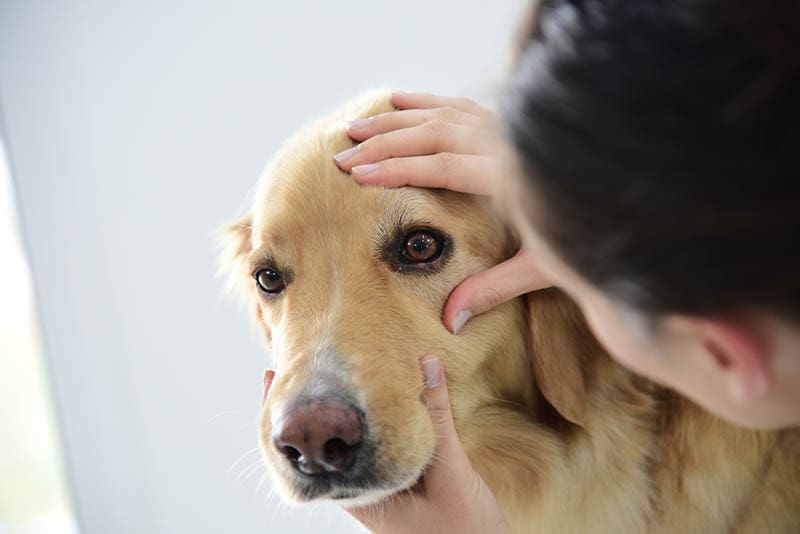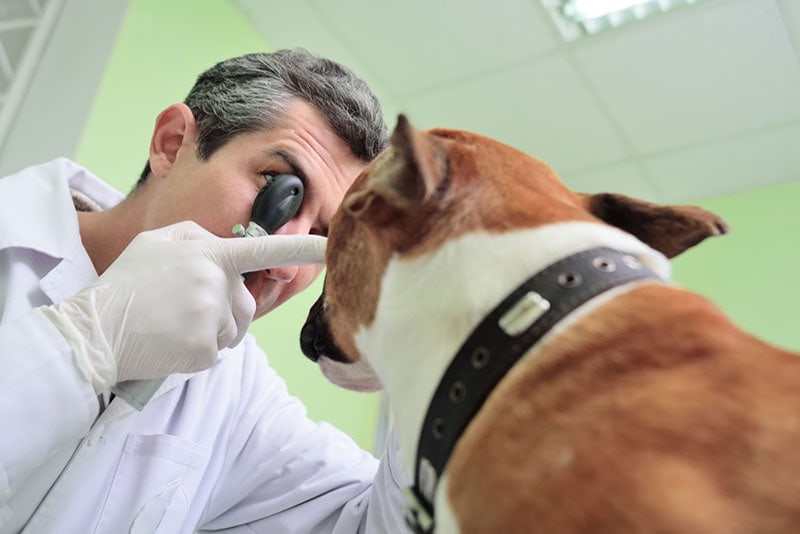At What Age Do Dogs Lose Their Eyesight? (Vet Answer)
Updated on

Click to Skip Ahead
Dogs make great pets, and they are in nearly half of the homes in the United States, but as they age, they can face many of the same health problems that humans do1. Some pet owners worry about their pet’s eyesight and when they might start to lose their vision if this ever happens. The short answer is that dogs with age-related eye problems may start to lose their vision from approximately 10 years of age, but there are many different factors to consider. Moreover, the manifestations of a decline in vision loss in dogs are more subtle than in humans because they can cope quite well with slight sight problems. Here, we examine the causes of vision loss and provide tips and tricks that can help keep your dog healthy.
Dog Movement Perception & Night Vision
Dogs have a different visual acuity compared to humans. Their vision is more attuned to detect motion and to perform very well in low-light conditions, enabling them to excel in activities like hunting and tracking. However, their ability to discern fine details is limited compared to humans.
Color Perception
Contrary to popular belief, dogs are not completely colorblind. While they don’t see the world in the same vibrant colors that we do, they can still perceive certain colors on a limited spectrum. They primarily see shades of blue and yellow.
Visual Field
Dogs have a wider field of vision than humans thanks to their laterally placed orbits. Dogs have approximately a 250-degree visual field, enabling them to see objects at wider angles. On the other hand, humans, with frontally placed eyes, have a 180-degree field of view.

Factors Affecting Canine Eyesight
Breed
Some breeds are more prone to congenital or hereditary vision issues, while others have relatively healthier eyes. For instance, Cocker Spaniels are susceptible to cataracts, glaucoma, progressive retinal atrophy, and dry eye, an immune-mediated condition that affects the tear gland. Meanwhile, Poodles are also prone to cataracts, glaucoma, progressive retinal atrophy, and optic nerve hypoplasia, a congenital condition that causes the optic nerve to develop fully and causes blindness in the affected eye.
Additional dog breeds prone to eye issues include English and French Bulldogs, Dachshunds, Siberian Huskies, Shih Tzus, Maltese, Collies, and Boxers, among others.
Health and Nutrition
A dog’s overall health and nutrition play a significant role in maintaining good eyesight. High-quality nutrition and regular veterinary check-ups are vital for keeping their eyes healthy and detect any eye issues early in order to tackle them in time. Consult with your vet promptly anytime you notice a change in your dog’s eyes or eyesight.
Many eye conditions will progress extremely quickly and can lead to permanent damage if not addressed at an early stage. Look for dog food brands that contain real meat as the first ingredient so you’re sure your dog is getting high-quality protein. Fish oil supplementation and antioxidants such as lutein, beta-carotene, vitamin C, and E may also play a role in keeping your dog’s eyes healthy.

Trauma and Injury
Accidents, fights, or other traumatic incidents can lead to eye injuries that may impact a dog’s vision. Immediate medical attention is crucial if you notice damage to the eye.
Aging
As dogs age, their eyes, like other organs, undergo a gradual decline in function and can be affected by health conditions that can affect vision, including cataracts, glaucoma, and retinal degeneration.

Vision Problems in Dogs
Cataracts
Cataracts are a common age-related issue in dogs. They cause clouding of the eye’s lens, leading to reduced vision. Small cataracts may not severely impact a dog’s eyesight, but large ones can result in blindness and other secondary eye problems.
Degeneration of the Retina
The retina is crucial for visual perception. As dogs age, the retinal function may decline leading to impaired vision. Dogs can also develop a condition called sudden acquired retinal degeneration syndrome (SARDS) that causes rapid blindness typically affecting dogs around 8 to 9 years of age. This condition can be linked to other signs of illness and initially affects a dog’s ability to see in low-light conditions, then progresses to complete vision loss.
Glaucoma
Glaucoma is a painful condition that almost inevitably leads to vision loss. It occurs when there’s an increase in pressure within the eye. Glaucoma tends to present in middle-aged to older dogs.
Progressive Retinal Atrophy
Progressive retinal atrophy is a group of genetic conditions that cause the gradual loss of function of the retina. This condition can lead to partial or complete blindness and is more common in certain breeds, including Labrador and Golden Retrievers, Toy Poodles, and Cocker Spaniels.

Do Dogs Typically Lose Their Eyesight?
Some dogs may retain their vision well into their senior years, while others might show signs of vision impairment earlier. The reasons for which a dog may lose vision are varied, the most important of which have been described above.
A very common situation in pet parents of dogs over 8 years old is to notice that their dog’s eyes have become cloudy and, as a consequence, to have doubts as to whether this means that their furry friend has lost vision. The good news is that, in many cases, the reason behind this change in your dog’s eyes can be something called “nuclear sclerosis.” This is a totally benign, age-related change in which the lens fibers, which continue to grow throughout life, condense, and give the lens a more opaque appearance. However it is not considered to cause any significant vision impairment in our pets.
Don’t hesitate to arrange a visit with your veterinarian if your dog’s eyes change in appearance; you will soon be able to find out for sure.
Signs of Vision Impairment in Dogs
- Bumping into objects
- Increased clumsiness
- Slow during walks
- Cloudy, bluish, or abnormally looking eyes
- Changes in behavior
- Sensitivity to light
- Avoidance of dark areas
Coping with a Visually Impaired Dog
- Avoid moving furniture or making significant changes to your dog’s living space.
- Use verbal commands to guide your dog.
- Consider using scents or textures to mark important areas in your home to help make it easier for your dog to find them in low-light conditions.
- Use scented or noisy toys to maintain their playfulness.
- Understand your dog’s health problem causing the vision impairment and attend frequent check-ups with your vet or veterinary ophthalmologist to monitor the progress.
- Be patient and understanding as your dog adjusts to their changing vision. There may be times when they are angry or afraid and need extra comfort.
Summary
Unfortunately, there is no way to tell if your dog will lose their eyesight, either completely or partially, and when this would happen. Most blinding eye conditions in dogs are linked to old age, but not all. Dogs’ eyes may naturally develop a cloudy appearance after 8 to 10 years of age. This is called nuclear sclerosis and doesn’t involve any vision loss.
Health issues that cause vision loss are more common in certain breeds, which are predisposed to different problems including retinal degeneration, cataracts, and glaucoma. However, other eye conditions can affect any dog and result from injury, underlying health problems, and age. Frequent check-ups with your veterinarian can help you detect any problems early.
Featured Image Credit: goodluz, Shutterstock















